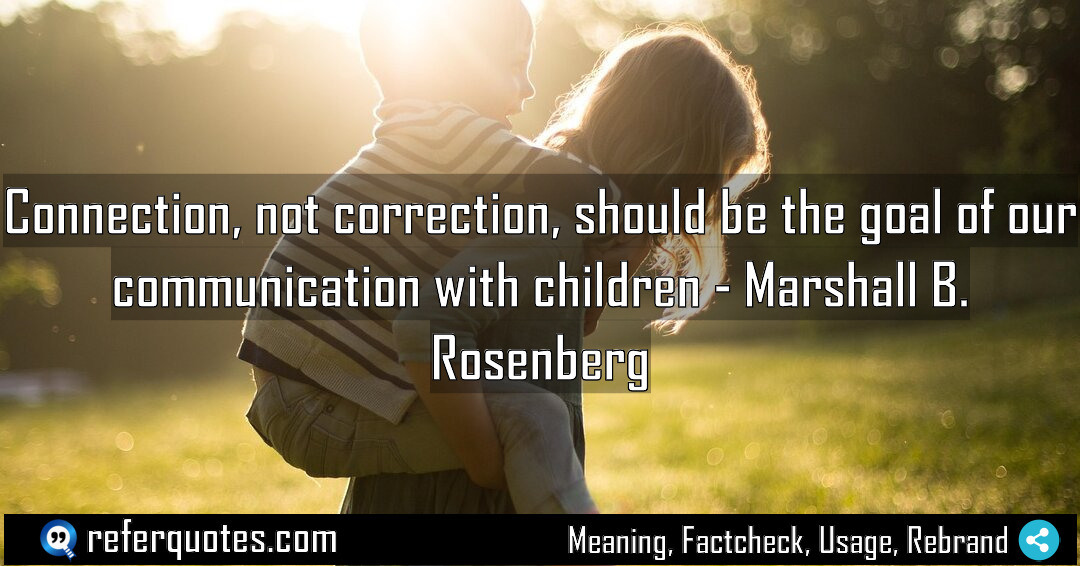
You know, “Connection, not correction” flips the entire script on traditional parenting. It’s about shifting from being a boss to being a bridge, and honestly, it changes everything once you get it.
Share Image Quote:
Table of Contents
Meaning
At its heart, this quote means our primary job in talking with kids isn’t to fix their behavior, but to understand the person behind it.
Explanation
Let me break it down. For years, I saw my role as a constant corrector. “Don’t do that.” “Say please.” And you know what? It creates a power struggle. It’s exhausting. Rosenberg’s genius is in pointing out that when a child feels truly heard and connected to you, the need for harsh correction just… evaporates. The good behavior becomes a natural byproduct of a secure relationship, not a forced obedience. It’s a long-game strategy that builds trust instead of resentment.
Quote Summary
Reading Level68
Aesthetic Score88
Origin & Factcheck
This comes straight from Marshall B. Rosenberg’s 2005 book, Raising Children Compassionately: Parenting the Nonviolent Communication Way. It’s a core tenet of his Nonviolent Communication (NVC) framework. You sometimes see it floating around unattributed, but it’s 100% Rosenberg’s work from the early 2000s in the United States.
Attribution Summary
Where is this quotation located?
| Quotation | Connection, not correction, should be the goal of our communication with children |
| Book Details | Publication Year/Date: 2004; ISBN/Unique Identifier: 9781892005140; Last edition: PuddleDancer Press, 1st Edition, 48 pages. |
| Where is it? | Chapter: Parenting the Nonviolent Way, Approximate page from 2004 edition |
Context
Rosenberg wasn’t just talking about quiet, peaceful moments. He was specifically applying this to conflict. When a kid is having a meltdown or acting out, that’s when our instinct is to correct the hardest. He argues that’s precisely the moment to pivot toward connection first.
Usage Examples
So how does this look in the wild? Let’s say your kid is refusing to put on their shoes.
- The Old Way (Correction): “Put your shoes on now, we’re late!”
- The Connection Way: Kneeling down. “You seem really frustrated about putting your shoes on. What’s going on?”
See the shift? You’re not ignoring the shoe problem, but you’re addressing the child first. This is gold for parents, teachers, and anyone who guides kids. It turns daily battles into opportunities for empathy.
To whom it appeals?
Share This Quote Image & Motivate
Motivation Score84
Popularity Score89
Shareability Score91
Common Questions
Question: But doesn’t this mean you’re just letting kids get away with bad behavior?
Answer: Not at all. It means you address the behavior *through* the connection. You set the boundary *after* you understand the unmet need. “I see you’re angry, and hitting isn’t okay. Let’s find another way to show me you’re upset.” The correction is still there, but it’s wrapped in understanding.
Question: Is this only for little kids?
Answer: Honestly, it works even better with teenagers. Trying to “correct” a teen is a recipe for a slammed door. Seeking connection, even when it’s hard, is the only way to keep the lines of communication open.
Question: What if I’m just too tired or angry to connect?
Answer: That’s the most human question. The goal isn’t perfection. It’s the intention. Sometimes the most connecting thing you can do is be honest: “I’m feeling too angry to talk well right now. I need a minute to calm down, and then I really want to understand what’s happening.” That’s still connection.
Similar Quotes
You know, “Connection is a more powerful teacher than correction” gets to the heart of what truly changes behavior. It’s a simple but profound shift from managing actions to nurturing…
When we focus on connection, correction follows naturally. It’s a game-changer that flips traditional discipline on its head. You stop fighting the symptoms and start addressing the root cause. Table…
You know, when Marshall Rosenberg said “Children need empathy more than they need correction,” he was getting at a profound shift in parenting. It’s not about letting kids run wild,…
Connection gives purpose and meaning to our lives… it’s a simple idea, but it’s the absolute bedrock of everything. I’ve seen this truth play out time and again in my…
Children learn how to communicate by the way we communicate with them. It’s a simple but profound truth that flips the script on traditional parenting. We’re not just teaching words;…
